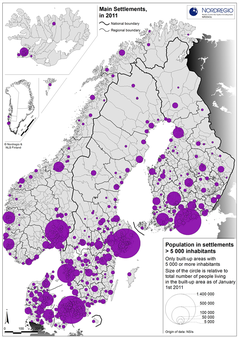Nordic Region
Theme: The Nordic Council of Ministers
The Nordic cooperation between governments is organised through the Nordic Council of Ministers, which next year turns 50. The Council has developed a new vision for 2030 with three clear goals: a green, competitive and socially sustainable Nordic region.
Inspired by TED Talks: Nordic podcast launch in the USA
Nordic Talks is the Nordic Council of Ministers’s own podcast series aimed at highlighting Nordic values to a global audience. The idea is also to create a lasting dialogue with the rest of the world.
New agreement for education on the Cap of the North
The Arctic Vocational Foundation has secured funding from Sweden, Finland and Norway for a further four years of vocational training for youths. A total of 285 youths will be trained every year.
Nordic governments: Everyone must join the fight against climate change
Fighting climate change is no longer a choice, but an absolute necessity which means our countries, our citizens and our industries must make great changes. That was the message from the Nordic prime ministers at the Nordic Council’s session in Stockholm.
The multi-faceted fight against sexual harassment
This October it is two years since the American actor Alyssa Milano sent out the first tweet with the hashtag #metoo. That set off a reaction that spread from Twitter to the streets and into the corridors of power. Suddenly sexualised violence and harassment was being discussed in a new way. But what has really changed in these three years?
Peter Hummelgaard: aims to secure early retirement for tired workers
The Danish labour market is facing major changes if Minister for Employment Peter Hummelgaard manages to get support for his plans. He wants to fight for fairer conditions for people with lower levels of education and for those in low-paid jobs.
What are the critical issues for Nordic trade unions?
What goes on inside the head of a trade union leader? At the NFS congress in Malmö they were challenged to spend one minute to describe what they see as the greatest challenge going forward. Here are some of the answers:
Editorial staff
Line Scheistrøen is editor-in chief of the Nordic Labour journal and its network of freelance journalists and photographers in all the Nordic countries as well as in Åland and the Faroe islands. In addition, Kerstin Ahlberg participates as an employment law expert and Lars Bevanger as a translator.
Nordic Labour Journal
is an online publication with articles by journalists and writers from the Nordic countries. We aim to produce news and features about working life in a Nordic perspective. Editor-in-chief is Line Scheistrøen.
Paula Lehtomäki wants a new Nordic passport union and a clearer Nordic Council of Ministers
Nordic citizens should be able to use digital ID and use digital services in neighbouring countries, says the new Secretary General of the Nordic Council of Ministers. She wants to continue delivering results that really benefit the region's citizens.
Document Actions



 Follow us on Facebook
Follow us on Facebook

